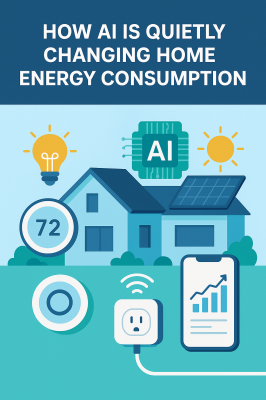Introduction
In recent years, artificial intelligence (AI) has moved beyond tech labs and research centers to become a part of our daily lives. From personalized recommendations on Netflix to advanced medical diagnostics, AI is everywhere. But one of the most overlooked yet impactful applications of AI lies in our homes—specifically in the way we consume energy.
As energy costs rise and climate change becomes a growing concern, households are seeking smarter ways to reduce their consumption. AI-powered solutions, such as smart thermostats, intelligent lighting, and predictive energy management systems, are quietly reshaping the way we use electricity.
This article explores how AI is transforming home energy consumption, the benefits it offers, and what the future holds.
1. Smart Thermostats: The Brain of Energy Management
Smart thermostats like Google Nest and Ecobee are more than just digital controllers. They learn your daily routines—when you wake up, when you leave for work, and when you return home.
-
How they work:
-
Use machine learning to predict heating/cooling needs.
-
Adjust temperature based on occupancy and weather conditions.
-
Connect with utility companies to optimize usage during peak hours.
-
👉 According to the U.S. Department of Energy, smart thermostats can save homeowners 10-15% annually on heating and cooling bills.
2. Intelligent Lighting Systems
Traditional lighting is wasteful—people often forget to turn off lights. AI-powered lighting systems, like Philips Hue integrated with AI assistants, solve this problem.
-
Features:
-
Motion sensors + AI to detect presence.
-
Adaptive lighting based on natural daylight.
-
Integration with voice assistants (Alexa, Google Assistant).
-
This not only reduces electricity consumption but also improves comfort and ambiance.
3. Predictive Energy Usage
AI algorithms can analyze your historical electricity usage and predict future consumption patterns.
-
Example: If your washing machine typically runs every Saturday morning, AI can suggest the most cost-efficient time to run it based on electricity tariffs.
-
Utility companies in Europe and the U.S. are already testing dynamic pricing combined with AI recommendations.
4. AI in Smart Appliances
Refrigerators, washing machines, and even ovens are now AI-enabled.
-
Refrigerators can monitor food freshness and adjust cooling.
-
Washing machines optimize water and detergent usage.
-
Smart plugs allow AI to shut off idle devices automatically.
These micro-adjustments may seem small, but collectively, they create significant savings.
5. Sustainability and Environmental Impact
One of the biggest benefits of AI in energy management is its contribution to sustainability. By reducing unnecessary energy consumption, AI helps lower carbon footprints.
-
Smart homes can cut energy usage by 20-30% annually.
-
When scaled across millions of households, this could have a massive impact on reducing global emissions.
6. Challenges and Concerns
While the potential is huge, there are challenges:
-
Privacy issues: AI requires data to learn user habits.
-
Upfront costs: Smart devices are still expensive for some households.
-
Dependence on tech companies: Reliance on cloud-based AI can raise concerns about security.
7. The Future of AI in Home Energy
By 2030, experts predict that nearly every household device will have some level of AI integration. We can expect:
-
AI-powered solar panel optimization for homes.
-
Peer-to-peer energy trading using blockchain and AI.
-
Even fully autonomous homes that regulate themselves with minimal human input.
Conclusion
AI is quietly reshaping how we consume energy at home. From smart thermostats to predictive appliances, it not only saves money but also supports sustainability. As technology advances, the role of AI in energy management will only grow stronger—making our homes smarter, greener, and more efficient.
